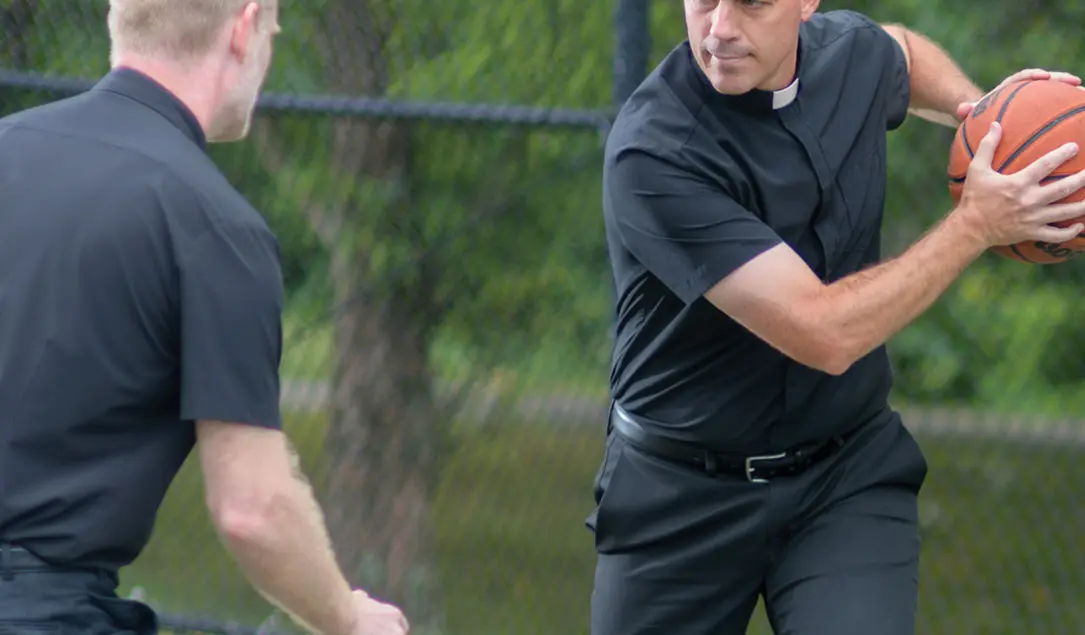
clergy shirt
Share
What is a clergy shirt?
A clergy shirt is a specialized shirt worn by ordained members of the clergy. It typically features a tab collar that fastens with a button at the front. The shirt is usually black, but it can also be found in other colors like white, blue, or gray. Many clergy shirts are made of a comfortable and durable fabric to ensure ease of movement during religious services and activities.
History and significance of clergy shirts
The clergy shirt has a history dating back to the 17th century when it became a symbol of religious authority. Clergy shirts are typically black or another solid color and feature a white collar, representing purity and distinction. These shirts are worn by clergy members during religious services and important ceremonies to signify their role in the church. In some denominations, the color and style of the clergy shirt can hold specific meanings tied to the church calendar or the clergy member’s rank within the church hierarchy. The significance of clergy shirts lies in their ability to visually distinguish clergy members and their commitment to their religious duties.
Types of clergy shirts
Clergy shirts come in various styles and colors to suit different needs. Common types include tab-collar shirts, neckband shirts, and full-collar shirts. Tab-collar shirts have a small tab that fastens the collar together, while neckband shirts have a detachable collar that fastens with buttons. Full-collar shirts have a traditional full collar that is attached to the shirt. Each type offers a different look and level of formality, allowing clergy members to choose based on personal preference and the occasion.
Traditional colors and symbols
Clergy shirts typically come in traditional colors like black, white, and grey. These colors are commonly associated with seriousness and professionalism. Additionally, clergy shirts often feature symbols like crosses or religious insignias to symbolize faith and devotion. The choice of color and symbols on a clergy shirt can vary based on personal preference, religious traditions, or ceremonial significance.
Materials used in clergy shirt manufacturing
Clergy shirts are commonly made from a blend of cotton and polyester fabrics to ensure durability and ease of care. The cotton provides a soft and breathable feel, while the polyester adds strength and helps the shirt maintain its shape. Some clergy shirts may also include a small percentage of spandex for added stretch and comfort. These materials are chosen to create a comfortable garment that is both easy to maintain and long-lasting.
How to choose the right fit
To choose the right fit for a clergy shirt, you should consider the following:
- Neck Size: Make sure the collar of the shirt fits comfortably around your neck without being too tight.
- Sleeve Length: Opt for sleeves that reach your wrist bone to avoid them being too short or long.
- Shoulder Width: Ensure the shirt’s shoulders align with your own for a proper fit.
- Body Fit: Decide on a slim, regular, or loose fit based on your preference and comfort.
- Fabric: Select a fabric that suits your needs, such as cotton for breathability or polyester for easy maintenance.
Clergy shirt accessories: collars and cuffs
Clergy shirts come with detachable collars and cuffs that can be interchanged for a fresh look without changing the whole shirt. The collars are typically white and can vary in styles such as tab or full banded. The cuffs can also be switched to match the collar choice. This accessory feature allows clergy members to adapt their shirts to different occasions or personal preferences easily.
Maintenance and care tips
To keep your clergy shirt looking crisp and professional, it’s important to follow some simple maintenance and care tips. Here are a few guidelines to help you preserve the quality of your clergy shirt for a longer period:
- Washing: Always follow the care instructions on the label of your shirt. Generally, it is recommended to wash your clergy shirt in cold water to prevent shrinking and fading.
- Ironing: To maintain a neat appearance, iron your clergy shirt on a low heat setting. Be careful around any embroidered or delicate areas to avoid damage.
- Storage: Hang your clergy shirt on a sturdy hanger to prevent wrinkles. Avoid overcrowding your closet to allow your shirt to breathe and maintain its shape.
- Stain Removal: Deal with any stains promptly by using appropriate stain removal techniques. Avoid using harsh chemicals that can damage the fabric.
- Repairs: Check your shirt regularly for loose threads, missing buttons, or any other signs of wear and tear. Make timely repairs to prevent further damage.
By following these simple maintenance and care tips, you can ensure that your clergy shirt stays in good condition and continues to make a positive impression.
Cultural variations in clergy attire
Clergy attire varies across cultures. For instance, Catholic priests often wear a black shirt with a white collar, while Protestant ministers may opt for more casual attire. Orthodox clergy might wear elaborate robes and hats. These differences in attire reflect the diverse traditions and practices within different religious denominations.
Modern trends in clergy shirt fashion
Clergy shirts have evolved over the years to suit modern fashion trends. Today, clergy shirts are available in a variety of styles, colors, and fabrics to cater to different tastes. Some common modern trends in clergy shirt fashion include slim-fit designs, trendy collar styles like tab collars or mandarin collars, and a wider range of color options beyond the traditional black and white. Additionally, clergy shirts now often feature more breathable and comfortable fabrics, making them practical for everyday wear.


